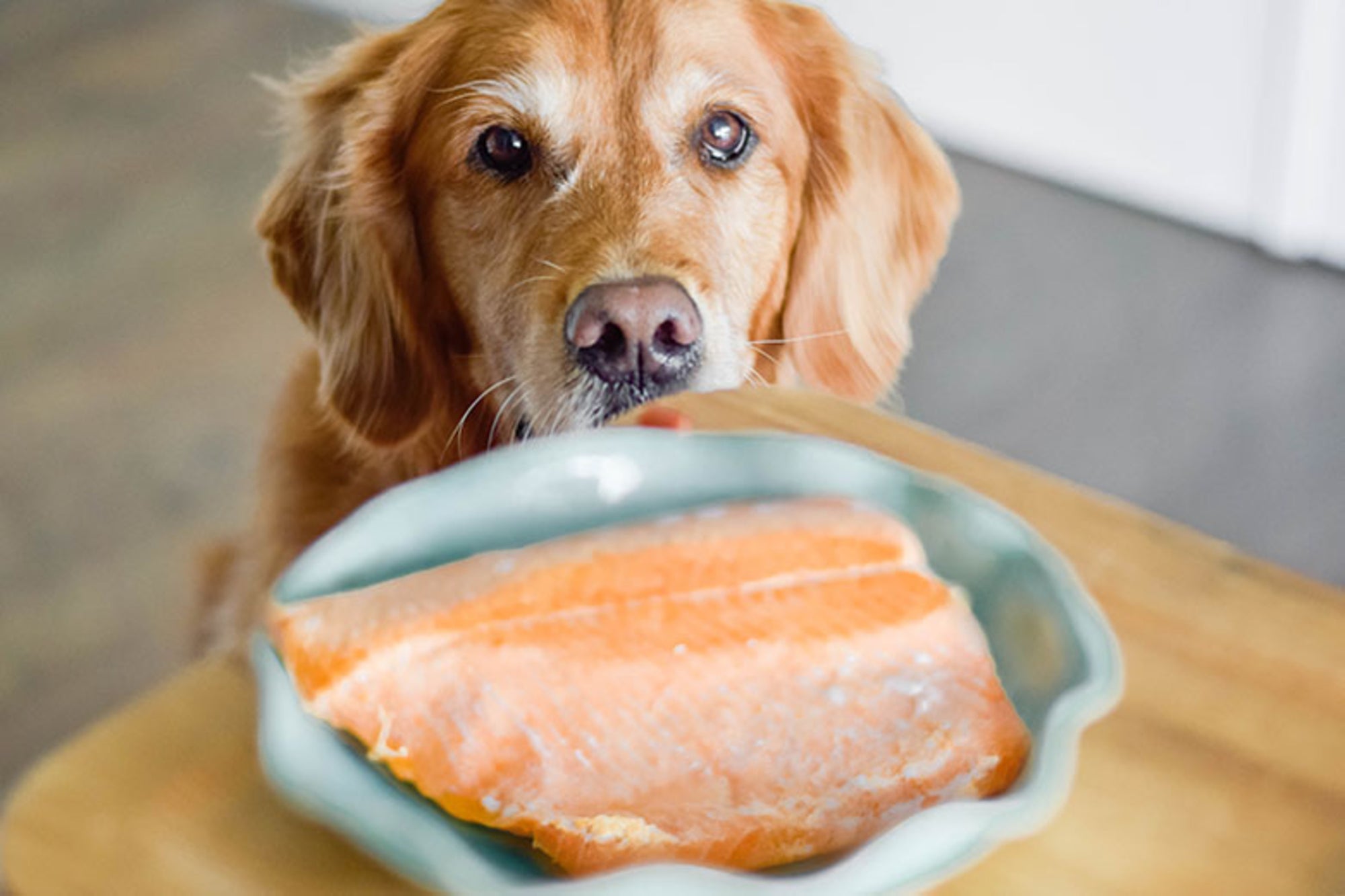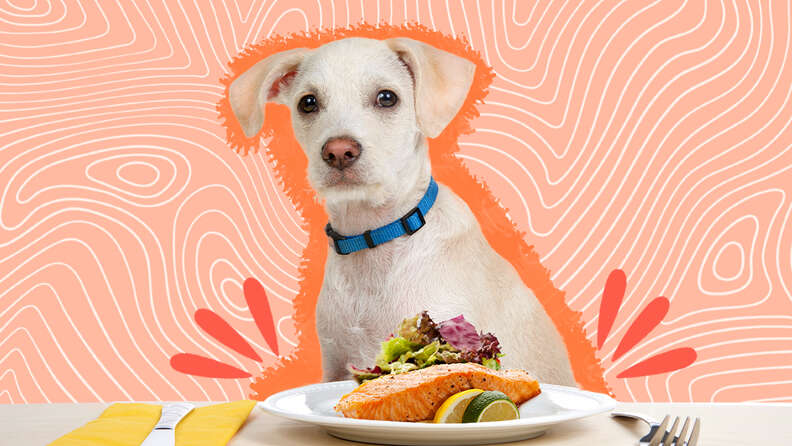Yes, dogs can eat salmon. It is safe and healthy for them.
But, there are things you should know. Salmon is a great source of protein and omega-3 fatty acids. These nutrients help your dog’s coat shine and support their overall health. But, you must prepare salmon the right way to avoid risks.
Raw salmon can carry parasites that harm your dog. Always cook the fish well and remove all bones before serving. This ensures your dog can enjoy the benefits safely. In the following sections, we will dive deeper into how to safely feed salmon to your dog, the benefits it offers, and the precautions you need to take. Keep reading to learn more.
Introduction To Salmon For Dogs
Salmon can be a healthy treat for dogs. Packed with omega-3 fatty acids, it supports their coat and immune system. Always cook it thoroughly to avoid parasites.
Salmon is a popular fish among humans. But can dogs eat salmon? Yes, they can! Salmon can be a healthy addition to your dog’s diet. It offers many benefits, making it a great choice. Let’s explore why salmon is good for dogs and its nutritional value.Why Salmon?
Salmon is rich in omega-3 fatty acids. These acids support your dog’s skin and coat health. They also help reduce inflammation. This can benefit dogs with joint problems. Salmon is also a good source of protein. Protein is essential for muscle growth and repair.Nutritional Value
Salmon contains important vitamins and minerals. It has vitamins B12 and D. These vitamins support your dog’s energy levels. They also help maintain healthy bones. Salmon is also high in selenium. Selenium boosts the immune system. It helps fight off infections and diseases. Including salmon in your dog’s diet can be very beneficial. “`
Credit: www.nextritionpet.com
Health Benefits Of Salmon
Salmon offers many health benefits for dogs, including improved coat health and a stronger immune system. Rich in omega-3 fatty acids, it supports heart health and reduces inflammation.
Salmon is a nutritious fish that offers many benefits for dogs. It is packed with essential nutrients that support overall health. Many pet owners consider adding salmon to their dog’s diet for its numerous advantages.Omega-3 Fatty Acids
Omega-3 fatty acids in salmon are vital for dogs. These fats support heart health and reduce inflammation. They help maintain a shiny coat and healthy skin. Omega-3s also boost brain function and improve joint health.Protein Content
Salmon is a rich source of high-quality protein. Protein is essential for muscle growth and repair. It keeps dogs strong and energetic. A diet with adequate protein supports a healthy immune system. It also aids in the production of hormones and enzymes. “`Potential Risks Of Feeding Salmon
Feeding salmon to dogs carries potential risks. Raw or undercooked salmon can contain harmful parasites, leading to severe health issues. Always ensure salmon is thoroughly cooked and deboned.
Feeding salmon to your dog might seem like a healthy option, but there are potential risks you should be aware of. Understanding these risks can help you make better choices for your furry friend’s diet.Parasites And Bacteria
Raw salmon can contain parasites and bacteria that are harmful to dogs. For example, salmon poisoning disease (SPD) is caused by a parasite found in salmon. This can lead to severe illness and even death. Cooking salmon thoroughly can help eliminate these risks. Always ensure that the salmon you feed your dog is well-cooked and free from bones.Mercury Levels
Salmon, like many fish, can contain mercury. High mercury levels can be toxic to dogs. It can affect their nervous system and overall health. It’s crucial to limit the amount of salmon your dog eats. Consider giving salmon as an occasional treat rather than a regular meal. Have you ever thought about the long-term effects of mercury on your dog’s health? It’s important to be cautious and proactive. By being informed and vigilant, you can provide your dog with safe and nutritious meals without the risks associated with salmon. Remember, their health is in your hands.
Credit: www.thedodo.com
Preparing Salmon For Dogs
Feeding your dog salmon can be very beneficial. However, preparing it properly is crucial. Improper preparation can lead to health issues. Let’s explore how to prepare salmon for your furry friend.
Cooking Methods
Cooking salmon for dogs is essential. Raw salmon can contain parasites. Bake, grill, or steam the salmon. Ensure it is fully cooked through. Avoid frying as it adds unnecessary fat.
Baking is simple. Preheat your oven to 350°F. Place the salmon on a baking sheet. Cook for about 15-20 minutes. Ensure the salmon is flaky and opaque. Grilling is another option. Grill the salmon on medium heat. Cook each side for 4-5 minutes. Steaming is quick and easy. Place the salmon in a steamer basket. Steam for 10-12 minutes. Check that the fish is fully cooked.
Avoiding Seasonings
Dogs have sensitive stomachs. Seasonings can harm them. Avoid salt, garlic, and onions. These are toxic to dogs. Also, skip the butter and oils. They are not necessary and add fat.
Simple is best. Cook the salmon plain. Your dog will still enjoy the taste. Focus on the natural flavors. Avoid adding any spices. Your dog’s health is the top priority.
Serving Size And Frequency
Understanding the right serving size and frequency for feeding salmon to your dog is crucial. Dogs can benefit from the nutrients in salmon, but overfeeding can lead to issues. Ensuring you get the balance right will keep your dog healthy and happy.
Portion Control
When feeding your dog salmon, portion control is key. Too much salmon can cause stomach upset or other issues. A small portion, about 10% of their daily food intake, is generally safe. This means a small dog might get a tablespoon, while a larger dog might get a few tablespoons.
Always remove bones from the salmon. Bones can cause choking or damage their digestive tract. Ensure the salmon is cooked thoroughly. Raw salmon can carry parasites that harm your dog.
How Often
Feeding salmon to your dog should not be a daily routine. Once or twice a week is enough. This frequency ensures your dog gets the benefits without overloading on any particular nutrient.
Introduce salmon gradually into your dog’s diet. Watch for any signs of allergies or digestive issues. If your dog shows any adverse reactions, stop feeding salmon and consult your vet.

Credit: www.nextritionpet.com
Signs Of Salmon Allergy
Dogs love treats, especially when they are fish-based. Salmon is a popular choice due to its high nutritional value. Yet, some dogs might be allergic to salmon. Knowing the signs of a salmon allergy can help keep your furry friend safe and healthy.
Symptoms To Watch
Dogs with a salmon allergy may show several symptoms. These symptoms can appear within minutes to hours after eating salmon. Common signs include itching, redness, and swelling.
Vomiting and diarrhea are also possible signs. Your dog might have trouble breathing. In severe cases, anaphylactic shock can occur. This is a life-threatening condition. Always observe your dog after introducing new foods.
What To Do
If you suspect your dog has a salmon allergy, stop feeding it salmon immediately. Watch for any changes in symptoms. Consult your vet as soon as possible. They may suggest an allergy test to confirm the diagnosis.
Your vet may prescribe medication to manage symptoms. They might also recommend a special diet. Avoid all fish-based products until you have a clear diagnosis. Keeping your dog safe and comfortable is the priority.
Alternatives To Salmon
Sometimes, you may want to give your dog a break from salmon or simply try something new. It’s always good to have a variety of options to keep your dog’s diet balanced and interesting. Here are some healthy alternatives to salmon that you can consider for your furry friend.
Other Fish Options
Different fish can offer similar health benefits to salmon. Cod is a great option. It’s low in fat and high in protein, making it a good choice for dogs who need to watch their weight. Sardines are also excellent—they are small, easy to eat, and packed with omega-3 fatty acids.
If you’re looking for something a bit different, try whitefish. It is usually available in pet stores and is known for being gentle on the stomach. Herring is another fish that is high in omega-3s and vitamins, which can contribute to a shiny coat and healthy skin.
Non-fish Protein Sources
Fish isn’t the only way to provide your dog with a healthy protein source. Chicken is a popular choice among many dog owners. It’s affordable, easy to prepare, and most dogs love it. Just make sure to remove any bones.
Turkey is another excellent alternative. It is lean and provides essential nutrients without too much fat. Additionally, you can try beef for a change. Opt for lean cuts to avoid excessive fat.
For something different, consider lamb. It’s a rich source of protein and can be an excellent option for dogs with food sensitivities.
What other proteins have you tried for your dog? Have they shown a preference for any specific type? Experimenting with different foods can be a fun way to discover what your dog loves most while keeping their diet balanced and nutritious.
Frequently Asked Questions
Can I Feed My Dog Cooked Salmon?
Yes, you can feed your dog cooked salmon. Ensure it is plain, boneless, and fully cooked to avoid health risks.
How Much Salmon Can I Give My Dog?
You can give your dog salmon once or twice a week. Limit portions to about 100 grams per serving. Ensure it’s cooked and boneless.
What Fish Can Dogs Not Eat?
Dogs should not eat raw salmon, trout, or any fish with high mercury levels like swordfish and shark.
Can Salmon Dog Food Upset Dogs’ Stomach?
Yes, salmon dog food can upset some dogs’ stomachs. Introduce it gradually and monitor for any adverse reactions.
Conclusion
Feeding your dog salmon can be a healthy choice. Rich in omega-3 fatty acids, it supports their coat and joints. Always cook the salmon well. Remove bones to prevent choking hazards. Check for any signs of allergies. Start with small portions.
Monitor your dog’s reaction. Consistent moderation is key. Consult your vet for advice tailored to your dog. A balanced diet keeps your furry friend happy and healthy. Enjoy safe, happy feeding times!
